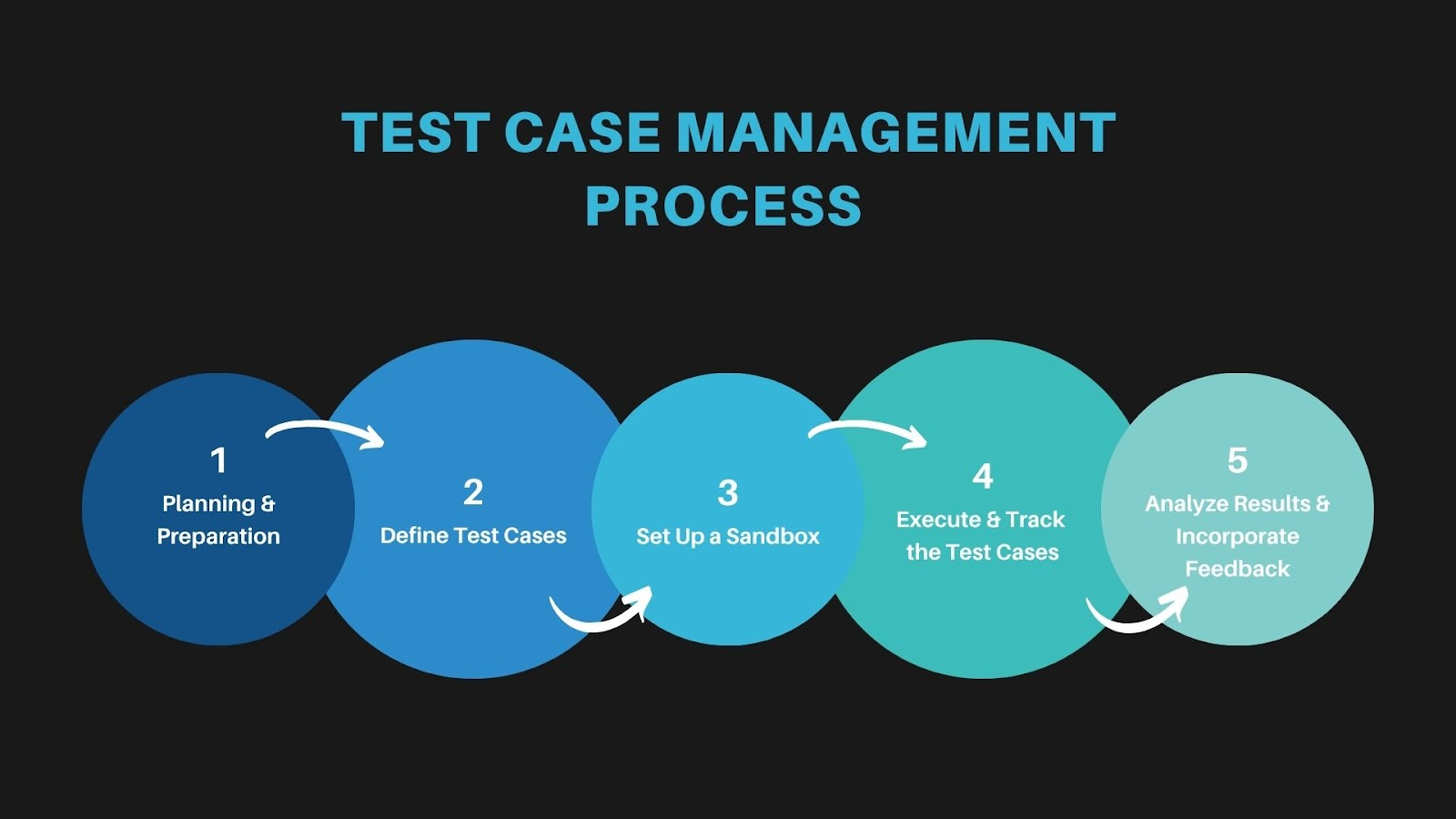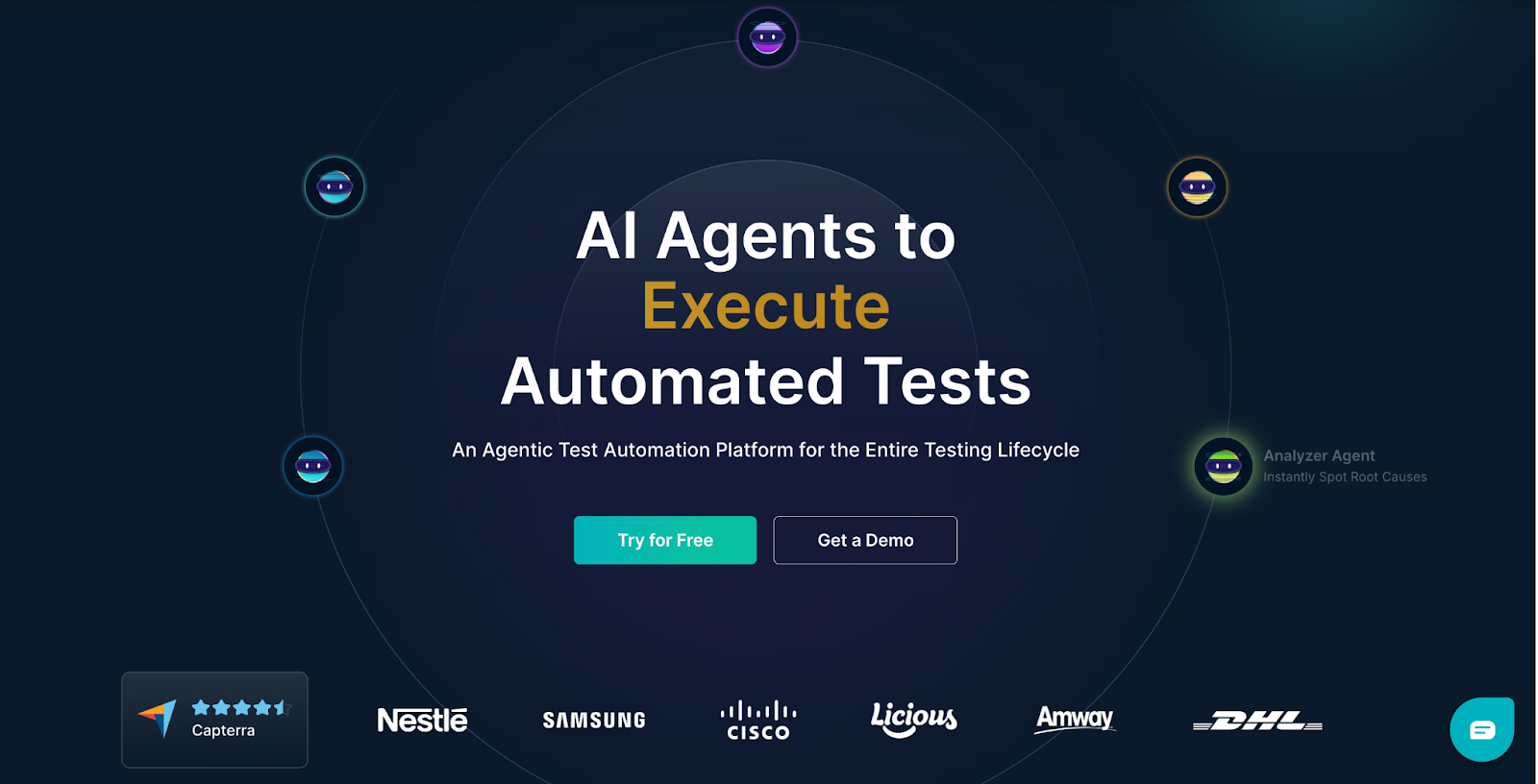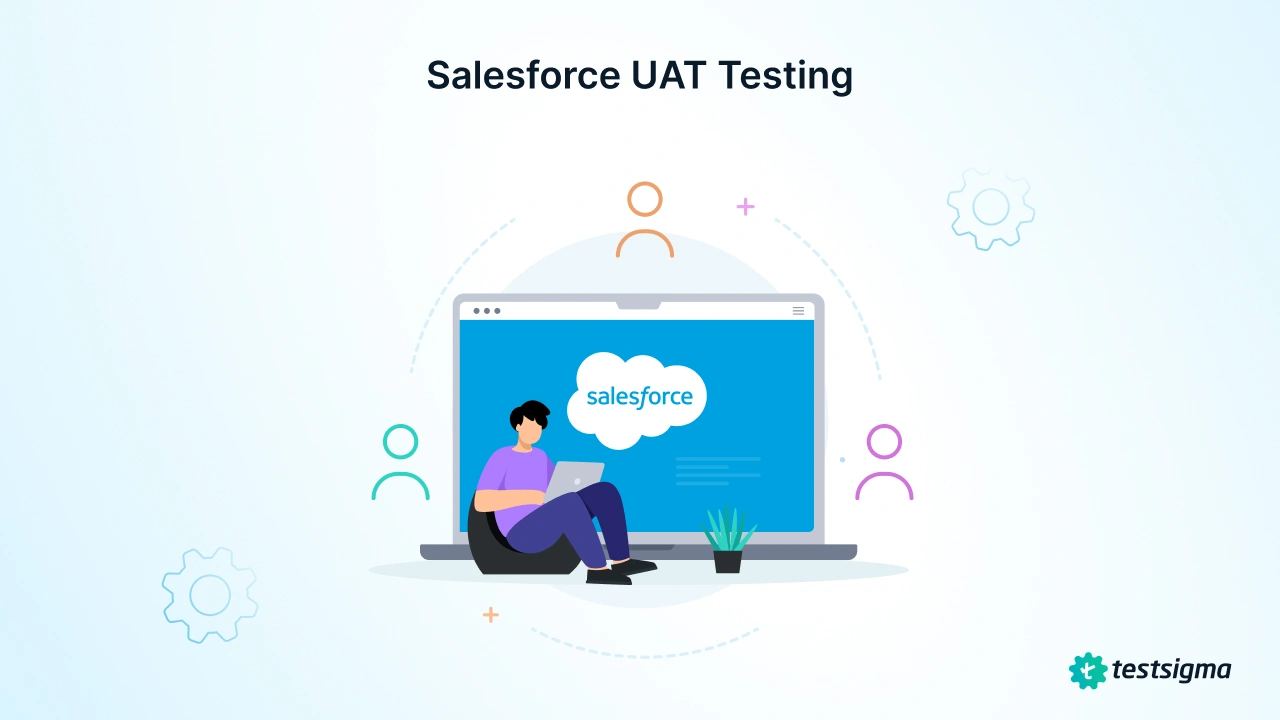Salesforce receives frequent updates on new feature enhancements and custom developments. That’s why Salesforce User Acceptance Testing (UAT) has become a crucial step to ensure everything functions as expected before going live. In this blog, we’ll explore what Salesforce UAT involves, the different types of tests, common challenges, and best practices to get it right.
Table Of Contents
- 1 What is Salesforce UAT?
- 2 What are the Different Types of Salesforce User Acceptance Tests?
- 3 Why Do We Need UAT for Salesforce?
- 4 What are the Steps in a Salesforce User Acceptance Testing?
- 5 What is the Difference Between Salesforce UAT and Functional Testing?
- 6 Best Practices for Salesforce UAT
- 7 What are the Essential UAT Salesforce Test Cases
- 8 Common Challenges in Salesforce UAT and How to Overcome Them
- 9 Simplify Salesforce UAT with Testsigma
- 10 Summing Up
What is Salesforce UAT?
Salesforce User Acceptance Testing (UAT) means end-user testing of the Salesforce system to ensure it meets the business requirements and functions as intended before going live. UAT in Salesforce is typically done in a sandbox or staging environment. It is the final checkpoint before deployment to production and happens after the system has been developed and tested. It is performed by business stakeholders like sales managers to simulate how real users would interact with the system.
Do not confuse Salesforce UI testing with UAT. They both serve different purposes.
What Are the Different Types of Salesforce User Acceptance Tests?
- Alpha Testing
This is conducted by the internal team of testers or developers. They execute core business scenarios to validate the basic functionalities and discover and fix major issues. This type of Salesforce UAT is done early in the testing cycle within a controlled environment.
- Beta Testing
Beta testing is done by selected end users, often from various business roles. Testing in this phase focuses on reliability, security, and user satisfaction, which means that the beta testers focus on what the system should do without any regard for the underlying code.
- Black Box Testing
Black box testing in Salesforce UAT means evaluating the functionalities, purely from the end-user’s perspective, without any awareness of the internal code or configuration. It is a technique rather than a testing phase, and is usually carried out along with Beta testing. Users simply input data and check the outputs against the expected results.
- Operational Testing
This type focuses on how Salesforce will perform under production-like conditions and includes stress, performance, and security checks. For example, it tests how long a page takes to load under heavy data loads. This is essential to ensure the system’s reliability and security.
Why Do We Need UAT for Salesforce?
- Frequent Changes in Configuration
Salesforce gets frequent updates and multiple new releases even within a year. UAT ensures that new configurations, such as adding fields or automations, still work as expected.
- Complex Workflows
Salesforce processes often span multiple objects, approvals, and clouds. UAT validates these complex business flows end-to-end.
- Third-Party Integrations
Enterprises often use multiple Salesforce clouds (Sales, Service, Marketing, etc), and integrate them with other systems such as ERP, billing, etc. UAT ensures that data and processes flow correctly between these integrations or systems. However, this is not the same as Salesforce Integration Testing that checks if systems connect and exchange data correctly, while UAT ensures the entire flow works as expected for end users in real-world scenarios.
- Customizations
Salesforce allows deep customizations, and each user role might have a different experience and permissions. Salesforce UAT is essential to check that these customized experiences meet the users’ requirements.
What Are the Steps in a Salesforce User Acceptance Testing?
A structured UAT of Salesforce follows these steps:

Step 1: Planning & Preparation
Collaborate with different stakeholders and set clear goals and expectations for the new Salesforce functionality being tested. Document the user stories or business scenarios that must be evaluated, and determine which user roles or profiles will participate in the testing process.
Step 2: Define Test Cases
Based on the goals and real-world user-based scenarios observed, develop test cases covering both typical and edge cases.
Step 3: Set up a Sandbox
A sandbox that mirrors the production environment and has representative data allows UAT to uncover issues that might only appear with high data volumes or specific data sets.
Step 4: Execute & Track the Test Cases
Once the test cases are prepared, they are run in the sandbox, and any unexpected outcome is recorded. Log all the defects or bugs in a tracking system, and when these are fixed, re-run the affected test cases to confirm the issues are resolved.
Step 5: Analyze Results & Incorporate Feedback
Examine the test results and determine if the functionalities meet the business and user requirements. Document any user feedback for future sprints or releases.
What is the Difference between Salesforce UAT and Functional Testing?
| Aspect | Salesforce UAT | Functional Testing |
| Objective | Validates that the system meets business requirements and user expectations | Verifies that each feature works according to technical specs |
| Focus | Business processes and end-user experience | Individual functionalities and technical details |
| Tested By | End users, business analysts, or other business stakeholders | QA engineers, developers |
| Environment | UAT sandbox/staging (mirrors production) | Development or QA test environments |
| Test Cases | User-centric scenarios covering real workflows | Functionality-focused scenarios (each feature or component) |
| Success Criteria | System supports real-world business operations | Each technical requirement is met (pass/fail of features) |
| Failure Implication | When system does not meet user needs | When there is a defect in a specific feature or technical flaw |
| Timing in Cycle | After functional and integration testing, just before release | Throughout the development cycle (unit, integration, system phases) |
Best Practices for Salesforce UAT
- Engage Real-End Users for Testing
For the UAT team, choose people from different user roles who also know the business context well and train them well. This helps acquire diverse perspectives and feedback and uncover more edge cases.
- Use a Realistic Test Environment
The sandbox for Salesforce UAT should closely mirror the production environment in terms of features, data volumes, configuration, and so on. Use representative data to uncover real-world issues.
- Communicate Proactively
Right from the beginning of UAT in Salesforce, maintain regular check-ins and collaboration between testers, developers, and other stakeholders to report, fix issues, and schedule re-runs in a timely manner.
- Leverage Automation
Automating Salesforce regression testing scenarios saves time. Automated UI or API tests can quickly re-verify unchanged features after each fix. For example, automated smoke tests can validate that core functionality still works after a release to UAT. Automation does not replace the need for manual scenario testing, but it augments UAT by handling routine checks efficiently. Use automation platforms like Testsigma, which focuses explicitly on Salesforce testing for a smoother experience.
Do you know the best Salesforce automation testing tools?
What Are the Essential UAT Salesforce Test Cases
The table below has some of the basic Salesforce test cases for UAT:
| Test Case Type | Description | Example |
| User Roles and Permissions | Ensure users can access only what they’re allowed to, based on their role. | Log in as a Sales Manager and verify access to create/edit leads. Log in as a Read-Only user and confirm they cannot modify any records. |
| Lead and Opportunity Management | Validate core sales processes like lead creation, assignment, and conversion. | Create a new lead with all required fields, confirm it gets assigned based on assignment rules, convert the lead, and verify that a linked Account, Contact, and Opportunity are created. |
| Opportunity Pipeline | Test opportunity stages, products, and related revenue or workflow logic. | Create an opportunity, move it through stages (e.g., Prospecting → Proposal), add products, apply a discount, and verify stage-specific triggers like approval or email alerts are fired. |
| Workflow and Automation | Confirm approval processes, Process Builders, Flows, and notification logic function as expected. | Submit a discount request >10%, verify that the approval process is triggered, and that notification emails or follow-up tasks are generated automatically. |
| Custom Objects and Fields | Test custom business entities and ensure data relationships and validations work. | Create a custom “Project” record linked to an Account, ensure the “End Date” cannot be before “Start Date,” and validate the related Account lookup and roll-up summary fields. |
| Data Integrity | Simulate end-to-end business flows to ensure data consistency across records and modules. | Complete a Quote → generate an Order → generate an Invoice → confirm amounts and values sync correctly across all records and are reflected in reports. |
| Reports and Dashboards | Ensure reports and dashboards reflect accurate data based on the latest configuration changes. | Run a sales pipeline report, verify it includes all active opportunities, and display correct totals and charts. |
Common Challenges in Salesforce UAT and How to Overcome Them
- Lack of Clear Test Scenarios
Challenge: End-users test based on their assumptions rather than documented scenarios, leading to inconsistent testing and missed edge cases.
Solution: When creating test scenarios for Salesforce UAT, always collaborate with business analysts or other business stakeholders to ensure that they mirror real-world scenarios. Document these steps, expected outcomes, and the required data so users can follow them.
- Incomplete Test Data
Challenge: Lack of realistic data leads to failed user acceptance tests in Salesforce since they often don’t reflect real business scenarios.
Solution: Perform Salesforce UAT with production-like test data that includes various data, reflecting real customer cases, roles, and workflows.
- Environment Issues
Challenge: Similar to test data, unrealistic, slow, or misconfigured UAT environments can also cause testing errors.
Solution: The Salesforce UAT environment should mirror production as closely as possible.
- Undefined Acceptance Criteria
Challenge: It’s difficult to decide whether a test case has passed or failed without clear acceptance criteria.
Solution: Define the acceptance criteria for each feature and add them directly to the Salesforce User Acceptance test cases so that the reviewers can refer to them.
Simplify Salesforce UAT with Testsigma
Testsigma is an AI-powered codeless test automation platform that is also designed to make Salesforce testing and UAT easier for both business users and QA teams. User Acceptance Testing (UAT) in Salesforce is often complex. With frequent UI updates, metadata changes, and multiple environments like Developer Sandbox or Partial Copy, keeping test cases stable is a challenge. Most tools demand significant setup, custom scripts, or constant maintenance.
Testsigma enables end-to-end test automation with plain English test creation, automatic sync with Salesforce metadata, and built-in support for all major environments and interfaces, including Lightning, Classic, and LWC.
Many teams swear by Testsigma for reliable and hassle-free Salesforce testing.

Here’s how Testsigma offers a much simpler, smarter way to handle Salesforce UAT:

- Create Tests in Plain English, Without Coding
Testsigma uses NLP-based test creation that lets anyone write and automate Salesforce UAT in simple English. No coding or complex syntax. This means business users, not just technical testers, can contribute to test coverage.
- Start Testing Immediately, No Setup Needed
There’s no need to install anything or build infrastructure. You can begin running UAT in Salesforce from day one, directly from the cloud. Ideal for agile or fast-moving release cycles.
- Syncs Automatically with Salesforce Metadata
Testsigma directly integrates with Salesforce metadata APIs. Your test cases stay up to date even as your Salesforce org changes. When new fields, objects, or layouts are added, Testsigma adapts to these changes automatically, minimizing test breakage.
- Self-Healing Tests for Lightning and LWC
Salesforce UIs are dynamic, especially with Lightning and Lightning Web Components (LWC). Testsigma’s AI-powered self-healing detects and updates broken locators automatically, helping you reduce test maintenance by up to 70%.
- Built-In Support for All Test Types
From functional and integration testing to regression and visual checks, Testsigma covers all Salesforce testing needs in one platform. You can test across UI, APIs, databases, and multi-cloud services, without switching tools.
- Visual Testing with Smart Snapshots
Agentic AI in Testsigma supports smart visual testing that detects UI anomalies between builds. It compares visual snapshots and highlights meaningful layout or styling issues, ideal for catching unexpected UI regressions in Salesforce Lightning.
- Seamless Environment Management
Whether it’s a Developer Sandbox, Partial Copy, or Full Sandbox, Testsigma lets you test across environments with environment-specific configurations and metadata versions. This ensures your UAT reflects real-world user behavior before go-live.
- Advanced Agentic AI for Test Lifecycle
Testsigma introduces a set of intelligent agents that help with test generation, execution, analysis, and optimization. These AI agents work behind the scenes to improve coverage, suggest enhancements, and reduce manual effort throughout your UAT lifecycle.
- Native CI/CD and Version Control Integrations
Testsigma connects natively with Salesforce DevOps tools like Gearset, Copado, and Flosum, plus popular CI/CD systems like Azure DevOps. You can run UATs as part of your release pipelines and manage test assets through version control.
- Enterprise-Grade Performance and Reporting
Run tests in parallel across multiple Salesforce orgs or sandboxes. Get detailed execution logs, advanced failure analysis, and full cross-browser support. Testsigma also complies with SOC 2 Type II standards for enterprise-grade security and data integrity.
If you’re looking to automate Salesforce UAT without code, complex setups, or fragile tests, Testsigma gives you the fastest route to value. Most teams start seeing ROI within 21 days, with 50% faster regression cycles and 3x quicker releases.
Summing up
Many teams around the world rely on Salesforce as their CRM. Since the platform frequently rolls out new features and customizations to better serve its users, it’s important to make sure these updates truly meet user expectations. That’s where Salesforce User Acceptance Testing becomes essential, though it can also be challenging. In such cases, using a low-code automation platform like Testsigma, powered by Agentic AI, can simplify and speed up your Salesforce testing workflow. We hope this blog helped you understand Salesforce UAT more clearly.




